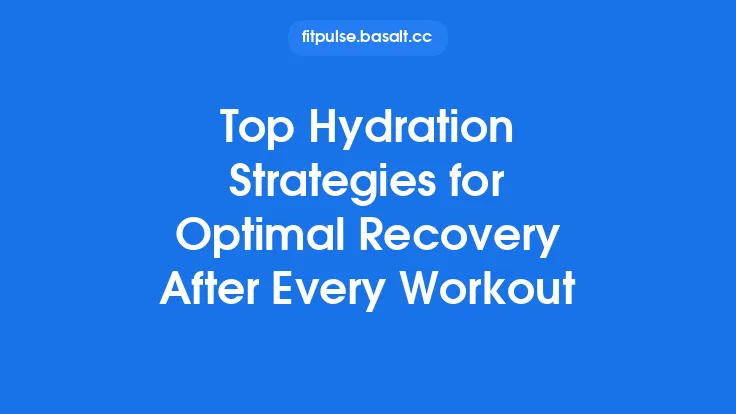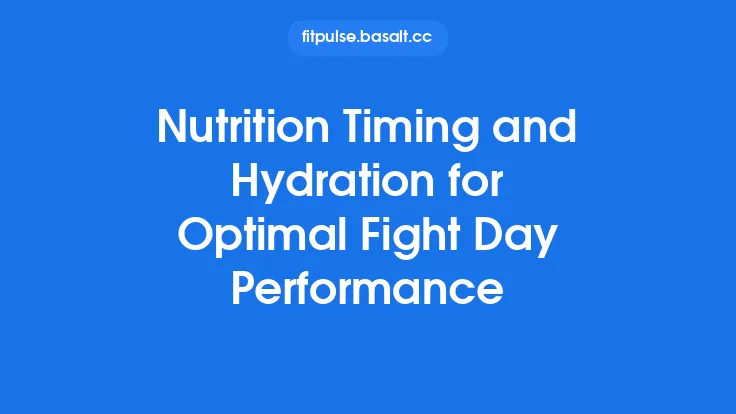When the temperature outside shifts, the body’s fluid needs do not stay constant. Even on a crisp winter morning, a cardio session can sap a surprising amount of water and electrolytes, while a scorching summer run can accelerate loss to the point where performance stalls or injury looms. Mastering hydration across the seasons is therefore a cornerstone of any cardio program that aims for consistent power output, efficient oxygen transport, and rapid recovery. Below is a comprehensive guide that walks you through the science, the self‑assessment tools, and the practical steps you can embed into your training calendar to keep hydration optimal year‑round.
Understanding Fluid Balance and Cardio Performance
Why water matters for the cardiovascular system
- Plasma volume: Blood is roughly 55 % plasma, a watery matrix that carries red blood cells, nutrients, hormones, and waste. Even a 2 % reduction in plasma volume can diminish stroke volume (the amount of blood ejected per heartbeat) and force the heart to beat faster to maintain cardiac output.
- Thermoregulation: Sweat evaporation is the primary means of dissipating heat during aerobic work. Adequate fluid reserves enable the skin’s sweat glands to produce the necessary volume without compromising blood pressure.
- Electrolyte equilibrium: Sodium, potassium, magnesium, and calcium maintain the electrical gradients that drive muscle contraction and nerve signaling. An imbalance can manifest as cramping, premature fatigue, or arrhythmias.
Physiological thresholds
- Mild dehydration: 1–2 % body mass loss → ↑ heart rate (≈ 5–10 bpm), ↓ VO₂max (≈ 5 %).
- Moderate dehydration: 2–4 % loss → noticeable performance drop, impaired thermoregulation, increased perceived exertion.
- Severe dehydration: > 4 % loss → risk of heat‑related illness, marked cardiovascular strain, possible hyponatremia if excess water is consumed without electrolytes.
Understanding these thresholds helps you set quantitative goals for each workout, regardless of season.
Seasonal Variations in Sweat Loss and Electrolyte Needs
| Factor | Summer (Hot & Humid) | Winter (Cold & Dry) |
|---|---|---|
| Sweat rate | 0.8–2.0 L h⁻¹ (often higher due to heat) | 0.4–1.0 L h⁻¹ (still significant, especially with high‑intensity intervals) |
| Sodium concentration | 40–80 mmol L⁻¹ (higher in hot climates) | 30–60 mmol L⁻¹ (still present; cold‑induced diuresis can concentrate plasma sodium) |
| Additional electrolytes | Potassium loss rises with higher sweat volume | Magnesium loss may be proportionally higher due to increased urine output |
| Fluid‑to‑heat ratio | Higher ambient temperature → greater need for isotonic fluids | Lower ambient temperature → risk of over‑cooling if fluids are too cold; preference for slightly warm drinks to avoid gastrointestinal discomfort |
Even in cold weather, the body continues to sweat—especially during vigorous cardio—so neglecting fluid intake can be just as detrimental as in summer. Moreover, cold‑induced diuresis (the body’s tendency to increase urine output in low temperatures) can silently chip away at total body water, making regular monitoring essential.
Assessing Your Personal Hydration Profile
- Sweat‑Rate Test
- Weigh yourself nude (or in minimal clothing) before a 60‑minute cardio session.
- Record fluid intake during the session (in milliliters).
- Weigh again immediately after the session, dry.
- Sweat loss (L) = (Pre‑weight – Post‑weight + Fluid intake) ÷ 1000.
- Divide by session duration to obtain L h⁻¹. Repeat in both summer and winter conditions for a seasonal baseline.
- Urine Color & Specific Gravity
- A light straw color (U‑scale 1–3) generally indicates adequate hydration. Darker hues suggest a need for more fluid.
- A handheld refractometer can measure specific gravity; values ≤ 1.020 are typical for well‑hydrated athletes.
- Body‑Mass Change Monitoring
- Track daily body mass at the same time each morning. Fluctuations > 1 % over a few days may signal chronic under‑ or over‑hydration.
- Electrolyte Sweat Testing (Optional)
- Commercial kits can analyze sodium and potassium concentrations in collected sweat. This data refines the electrolyte composition of your replacement drinks.
By establishing these personal metrics, you can move from generic “drink X liters per hour” advice to a data‑driven plan that respects your unique physiology and the seasonal environment.
Pre‑Exercise Hydration Strategies
| Goal | Summer (≥ 20 °C) | Winter (≤ 10 °C) |
|---|---|---|
| Fluid volume | 500–600 mL of water or isotonic beverage 2–3 h before the session; add 200–250 mL 15 min prior if urine is dark. | 400–500 mL of lukewarm water or mildly electrolyte‑enhanced drink 2–3 h before; 150–200 mL 15 min prior. |
| Electrolyte loading | Include 300–500 mg sodium (e.g., a pinch of sea salt or a sports drink) to pre‑empt higher sweat sodium loss. | A modest 150–250 mg sodium suffices; focus on maintaining plasma volume rather than replacing large sodium losses. |
| Temperature of fluid | Cool (≤ 15 °C) to lower core temperature before the workout. | Slightly warm (≈ 30 °C) to avoid gastrointestinal shock and to reduce the “cold‑stomach” effect. |
| Timing | Avoid large boluses within 30 min of start to prevent gastric discomfort. | Same principle applies; a small sip 5 min before start can be beneficial. |
Practical tip: A 250 mL bottle of water mixed with a quarter teaspoon of sea salt and a splash of citrus juice provides a quick, palatable pre‑exercise electrolyte boost without the sugar load of many commercial sports drinks.
During‑Exercise Fluid Replacement Tactics
- Match Fluid Intake to Sweat Rate
- Use the sweat‑rate data to set a target: Fluid (ml) = Sweat Rate (L h⁻¹) × Duration (h) × 1000 × 0.8–1.2.
- The 0.8 factor accounts for the fact that you will continue to lose fluid via respiration and urine; the 1.2 factor provides a safety margin for unexpected spikes in temperature or intensity.
- Choose the Right Beverage Osmolarity
- Isotonic (≈ 300 mOsm L⁻¹): Ideal for most cardio sessions lasting 60–90 min; balances rapid gastric emptying with electrolyte delivery.
- Hypotonic (< 200 mOsm L⁻¹): Best for shorter, high‑intensity intervals where carbohydrate delivery is less critical.
- Hypertonic (> 600 mOsm L⁻¹): Use sparingly, primarily for post‑exercise recovery or when carbohydrate loading is a priority.
- Electrolyte Ratios
- Sodium: 300–600 mg L⁻¹ (adjust upward in hot, humid conditions).
- Potassium: 150–250 mg L⁻¹ (helps maintain cellular membrane potential).
- Magnesium & Calcium: 20–30 mg L⁻¹ each; beneficial for muscle relaxation and preventing cramping.
- Practical Delivery
- Hand‑held bottles (500 mL) with a sip‑every‑5‑minute cadence work well for most runners and cyclists.
- Hydration packs (1–2 L) are advantageous for longer trail runs or bike rides, allowing hands‑free access.
- Electrolyte tablets dissolved in water provide flexibility; ensure they are fully dissolved to avoid gastric irritation.
- Temperature Management
- In summer, keep fluids ≤ 10 °C using insulated sleeves or ice‑filled bottles.
- In winter, aim for 15–20 °C; a small insulated thermos can maintain this range for the duration of a 90‑minute session.
Post‑Exercise Rehydration and Recovery
The 150 % Rule
- Replace 150 % of the fluid lost during the workout within the first 2 hours post‑exercise.
- Example: If you lost 1 L (based on pre‑/post‑session weigh‑in), consume 1.5 L of fluid, split between water and an electrolyte‑rich drink.
Carbohydrate‑Electrolyte Synergy
- Adding 30–60 g of carbohydrate per liter of rehydration fluid accelerates glycogen replenishment without overwhelming gastric capacity.
- Pair with 500–700 mg sodium per liter to enhance fluid absorption via the sodium‑glucose co‑transport mechanism.
Protein Integration
- A modest protein dose (10–20 g) within 30 minutes post‑cardio supports muscle repair, especially after high‑intensity interval sessions.
- Combine with the rehydration drink (e.g., a whey‑based shake mixed with an electrolyte solution) for a comprehensive recovery beverage.
Monitoring Success
- Re‑weigh within 30 minutes after rehydration; a return to within 0.2 kg of pre‑exercise weight indicates adequate fluid replacement.
- Observe urine color over the next 4–6 hours; it should shift back toward a light straw hue.
Practical Tools and Technologies for Monitoring Hydration
| Tool | What It Measures | How It Helps |
|---|---|---|
| Wearable Sweat Sensors (e.g., Gatorade Smart Cap, WHOOP) | Real‑time sweat rate, sodium concentration | Adjust fluid intake on the fly; detect unexpected spikes in loss. |
| Smart Water Bottles (e.g., HidrateSpark) | Volume consumed, reminders | Ensures consistent sipping; integrates with phone apps for daily targets. |
| Body‑Composition Scales with Bioimpedance | Total body water percentage | Tracks longer‑term hydration trends across weeks and seasons. |
| Urine Specific Gravity Meters | Urine density | Quick, inexpensive check before a session; alerts to under‑hydration. |
| Mobile Apps with Hydration Algorithms | Calculates personalized fluid needs based on weather, duration, sweat rate | Provides a simple daily plan without manual calculations. |
While technology can streamline data collection, the core principle remains: measure, compare, and adjust. Use these tools to validate the numbers you derived from your sweat‑rate tests, not as a substitute for them.
Common Pitfalls and How to Avoid Them
- Over‑reliance on Thirst
- Thirst lags behind a 1–2 % body‑water deficit. Schedule fluid intake proactively rather than waiting for the urge.
- One‑Size‑Fits‑All Beverage Choices
- A sports drink formulated for marathon runners may be too high in carbohydrates for a 30‑minute HIIT session, slowing gastric emptying. Match osmolarity to session length and intensity.
- Ignoring Electrolyte Balance
- Drinking large volumes of plain water in hot conditions can dilute plasma sodium, leading to hyponatremia. Include sodium in every replacement drink when sweat loss exceeds 0.5 L h⁻¹.
- Cold‑Weather “No‑Sweat” Myth
- Even when the air feels dry, vigorous cardio can produce 0.5–1 L of sweat per hour. Track weight loss to uncover hidden dehydration.
- Inconsistent Fluid Temperature
- Extremely cold drinks in winter can cause gastric cramping; overly warm fluids in summer impede cooling. Adjust temperature to the ambient environment.
- Neglecting Post‑Exercise Rehydration
- Skipping the 150 % replacement rule prolongs recovery, reduces subsequent performance, and can impair immune function.
Integrating Hydration into Your Seasonal Cardio Plan
- Quarterly Re‑assessment
- At the start of each season, repeat the sweat‑rate test under typical training conditions (e.g., a 60‑minute run at 70 % VO₂max). Update your fluid‑intake formulas accordingly.
- Periodized Fluid Strategies
- Base Phase (low intensity, longer duration): Emphasize steady isotonic intake, focus on sodium balance.
- Build Phase (higher intensity, shorter sessions): Shift toward hypotonic fluids, reduce volume per sip to avoid stomach upset.
- Peak Phase (race‑specific workouts): Simulate race‑day hydration plan, including temperature‑controlled drinks and timing of electrolyte tablets.
- Environmental Cue Checklist
- Before each workout, glance at the weather forecast: temperature, humidity, wind chill. Adjust fluid volume (+ 10–20 % for > 30 °C, – 5–10 % for < 5 °C) and electrolyte concentration accordingly.
- Logistics Integration
- Pack a pre‑measured bottle of your chosen beverage the night before. Use a labeled container for electrolyte tablets to avoid forgetting them on cold mornings.
- Education Loop
- Review post‑session data (weight change, urine color, perceived thirst) weekly. Discuss trends with a coach or training partner to refine the plan.
By embedding these steps into your training calendar, hydration becomes a predictable, data‑driven component rather than an afterthought. The result is a more stable plasma volume, smoother temperature regulation, and a consistent ability to hit target heart‑rate zones and power outputs—whether you’re pounding the pavement under a summer sun or carving trails through a winter frost.
Bottom line: Seasonal shifts alter how much you sweat, what you lose in electrolytes, and how your body reacts to fluid temperature. By quantifying your personal sweat profile, selecting the appropriate beverage composition, and timing intake before, during, and after each cardio session, you can safeguard performance and recovery across the entire year. Hydration, when treated with the same rigor as mileage or intensity, becomes a powerful lever for unlocking optimal cardio output—no matter the season.





